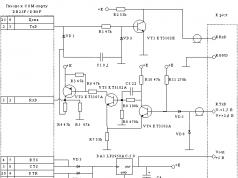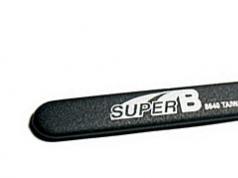All forces acting on the car from the road are transmitted through the wheels. The radius of a wheel equipped with a pneumatic tire may vary depending on the weight of the load, driving mode, internal air pressure, and tread wear.
Wheels have the following radii:
1) free; 3) dynamic;
2) static; 4) kinematic.
Free radius(r св) is the distance from the axis of a stationary and unloaded wheel to the most distant part of the treadmill. For the same wheel, the value of Rst depends only on the value of the internal air pressure in the tire.
The free radius of the wheel is indicated in the technical specifications of the tire. If the specified characteristic is not in the reference data, then its value can be determined by the tire marking.
Static radius(r st) - this is the distance from the center of a stationary wheel, loaded only by normal force, to the reference plane. The value of the static radius is less than the free radius by the amount of radial deformation:
r st = r st - h z = r st - R z /С sh, (5.1)
where h z = R z /С Ш - radial (normal) deformation of the tire, m;
R z - normal road reaction, N;
C w - radial (normal) tire stiffness, N/m.
The normal road reaction acting on one wheel can be determined by the formula:
R z = G O / 2, (5.2)
where G O is the weight of the car on a specific axle.
From formula (1) we find the value of the radial stiffness of the tire:
S w = R z / r st - r st, (5.3)
The radial stiffness of a tire depends on its design and internal air pressure p w. If the dependence of Cw on pw is known, then the amount of tire deformation can be determined at any internal air pressure. At rated air pressure and load, the static radius of the wheel can be found using the formula:
r st = 0.5d o + (1 - l w)N w, (5.4)
where d o - wheel rim diameter, m;
N w - height of the tire profile in the free state, m;
l w - coefficient of radial deformation of the tire.
For regular profile tires, as well as wide-profile tires, l w = 0.10 - 0.15; for arched and pneumatic rollers l w = 0.20 - 0.25.
The nominal value of rst of the wheel in relation to the rated load and internal air pressure is indicated in the technical specifications of the tire.
Dynamic radius(r d) is the distance from the center of the rolling wheel to the reference plane. The value of r d depends mainly on the internal air pressure in the tire, the vertical load on the wheel and its speed. As the vehicle speed increases, the dynamic radius increases slightly, which is explained by the stretching of the tire by centrifugal inertial forces.
Kinematic radius(r к) is the radius of a conditional non-deforming rolling wheel without sliding, which has the same angular and linear speeds with a given elastic wheel:
r k = V x /w k. (5.5)
The value of r k is determined empirically by measuring the path S covered by the car in n k full revolutions:
r k = V x /w k = V x * t /w k* t = S/2p n k, (5.6)
where V x is the linear speed of the wheel;
w k - angular speed of the wheel;
t - movement time.
The difference between the radii r d and r k is due to the presence of slipping in the area of contact of the tire with the road.
In the case of complete wheel slip, the path traveled by the wheel is zero S = 0, and therefore r k = 0. During sliding of braked, non-rotating (locked) wheels, i.e. when moving in a skid, n k = 0 and r k ® ¥.
When driving a car on roads with a hard surface and good grip, approximately r k = r d = r c = r.
A car (tractor) moves as a result of the action of various forces on it, which are divided into driving forces and forces of resistance to movement. The main driving force is the traction force applied to the drive wheels. Traction force arises as a result of engine operation and is caused by the interaction of the drive wheels with the road. Traction force Pk is defined as the ratio of the moment on the axle shafts to the radius of the drive wheels during uniform motion of the vehicle. Therefore, to determine the traction force, it is necessary to know the radius of the drive wheel. Since elastic pneumatic tires are installed on the wheels of the car, the radius of the wheel changes while driving. In this regard, the following wheel radii are distinguished:
1. Nominal – radius of the wheel in a free state: r n =d/2+H, (6)
where d – rim diameter, m;
H – total height of the tire profile, m.
2. Static r c – the distance from the road surface to the axis of the loaded stationary wheel.
r with =(d/2+H)∙λ , (7)
where λ is the radial deformation coefficient of the tire.
3. Dynamic r d – distance from the road surface to the axis of a rolling loaded wheel. This radius increases with a decrease in the perceived load of the wheel G k and an increase in the internal air pressure in the tire p w.
As the speed of the vehicle increases, under the influence of centrifugal forces, the tire stretches in the radial direction, as a result of which the radius r d increases. When a wheel rolls, the deformation of the rolling surface also changes compared to a stationary wheel. Therefore, the shoulder of application of the resultant tangential reactions of the road r d differs from r c. However, as experiments have shown, for practical traction calculations it is possible to take r c ~ r d.
4 Kinematic radius (rolling) of the wheel r k - the radius of such a conditional non-deformable ring that has the same angular and linear speeds with a given elastic wheel.
For a wheel rolling under the influence of torque, the tread elements that come into contact with the road are compressed, and the wheel at equal rotation speeds travels a shorter distance than during free rolling; on a wheel loaded with braking torque, the tread elements that come into contact with the road are stretched. Therefore, the brake wheel travels a slightly longer distance at equal speeds than a freely rolling wheel. Thus, under the influence of torque, the radius rк decreases, and under the influence of braking torque, it increases. To determine the value of r k using the “chalk prints” method, a transverse line is drawn on the road with chalk or paint, onto which a car wheel rolls, and then leaves prints on the road.
Measuring the distance l between the extreme prints, determine the rolling radius using the formula: r k = l / 2π∙n, (8)
where n is the wheel rotation speed corresponding to the distance l .
In case of complete wheel slip, the distance l = 0 and radius r to = 0. During sliding of non-rotating wheels (“SW”), rotation frequency n=0 and r to .
Some things sound boring and are difficult to remember, but you need to know them. Especially for car enthusiasts. Especially those who consider themselves experts and have their own opinion on any matter. The devil is in the details, and this article is about one such detail.
There is no radius on a tire
Many people now won’t even understand what I’m getting at. “Well, radius, so what? I have 195-65R15 wheels, radius 15, it’s all written down, why are you being clever?!” That's what I'm being smart about. R15 has nothing to do with radius. Neither R nor 15.
Nowadays you can find a lot of information on the Internet, but such little things as the marking of car tires are not among the most popular. We’d rather discuss engine power or the number of goodies in the cabin, right? And we’ll leave the choice of wheels to the store manager. Well, or we’ll ask a friend. He definitely knows! He already has his third car!
In fact, it won’t hurt to understand these boring numbers even just for general development. Moreover, this will both help save money and influence the behavior of the car, but more on that later. For now, it’s a pure educational program, so that later we can understand each other well.
So, 195/65R15. Classic case. Let's squat down next to our car. The first number is the width of the running part of the tire, roughly speaking, the tread width. Expressed in millimeters. That is 195 mm. - this is the width of your wheel. Most people have no problems understanding this figure.
Through the fraction 65 is the profile size. Expressed as a percentage of the width. Not in millimeters! The profile is the part of the tire that “sticks out above the rim.” Sidewall. That is, the height of this sidewall will be 195x65% = 125.75 mm. Not 65 mm. And not anything else. Moreover, from this diagram it clearly follows that the height of 65% with a width of 195 will be one, but if the tire is marked (conditionally) 225/65R15, it will be completely different! 225x65%=146.25 mm. Although the numbers 65 are the same!
R is the radial design of the tire, or more precisely, the way the metal cord is laid inside it. Once upon a time, the tire design involved diagonal laying, but that was a long time ago. Nowadays you almost never see “bias” tires, they are all radial, and the letter R will not tell anyone anything new, it will only cause controversy about the notorious radius...
And finally, the number 15. This is the diameter. The diameter of the tire seat, the inner diameter, the part that comes into contact with the disc. Expressed in inches. 1 inch = 2.54 cm. That is, 15x2.54 = 38.1 cm This is also the outer diameter of the disk, if anyone hasn’t guessed...
Which tires can be installed and which cannot?
And then the fun begins. We can play with these numbers if we want to put other tires (rims) on the car. Ideally, the main thing is that the overall diameter does not differ, or differs slightly. Example.
The 195/65R15 wheel has the following overall diameter: 38.1 cm - inside, plus 125.75 mm x2 = 251.5 mm (there is a profile at both the top and bottom). Let's convert to centimeters for simplicity, it turns out 38.1 cm + 25.15 cm = 63.25 cm. That's how it is! This is the total diameter of the wheel.
Now, if you want to install other wheels, the car owner must understand the following: automakers understand this figure the same way as we do. Taking into account the wheel diameter, the suspension, braking system and body are designed. Therefore, for the same car model (for example, for a Volkswagen Polo sedan), three wheel sizes are officially allowed. The simplest version is content with 175/70R14 (total diameter 60.06 cm), 185/60R15 (60.3 cm) and 195/55R15 (59.55 cm).
It turns out that the “14 wheel” is BIGGER, albeit slightly, than the 15 wheel in the case of 195/55. This is related to the question raised above, about putting on more wheels for the winter... You need to carefully calculate everything. Will a larger diameter number mean a larger wheel size overall? Not always.
The wheels of a car (Fig. 3.4) have the following radii: static r s, dynamic r D and rolling radius r quality.
Static radius is the distance from the axis of the stationary wheel to the road surface. It depends on the load on the wheel and the air pressure in the tire. The static radius decreases as the load increases and the air pressure in the tire decreases, and vice versa.
Dynamic radius is the distance from the axis of a rolling wheel to the road surface. It depends on the load, air pressure in the tire, speed and torque transmitted through the wheel. The dynamic radius increases with increasing speed and decreasing transmitted torque, and vice versa.
Rolling radius The ratio of the linear speed of the wheel axis to its angular speed is called:
The rolling radius, depending on the load, air pressure in the tire, transmitted torque, slipping and slipping of the wheel, is determined experimentally or calculated using the formula
(3.13.)
Where n to - number of full wheel revolutions; S K - the distance traveled by the wheel for the full number of revolutions.
From expression (3.13) it follows that when the wheel is completely slipping (S k = 0), the rolling radius r quality= 0, and with full sliding (n k = 0) g quality → oz.
As studies have shown, on roads with hard surfaces and good grip, the rolling radius, static and dynamic radii differ slightly from each other. Therefore it is possible
When performing calculations in the future, we will use this approximate value. We will call the corresponding value the radius of the wheel and denote it r k .
 For various types of tires, the wheel radius can be determined according to GOST, which regulates static radii for a number of load values.
For various types of tires, the wheel radius can be determined according to GOST, which regulates static radii for a number of load values.
ki and air pressure in tires. In addition, the wheel radius, m, can be calculated from the nominal tire dimensions using the expression
![]() (3.14)
(3.14)
Rice. 3.4. Wheel radii







